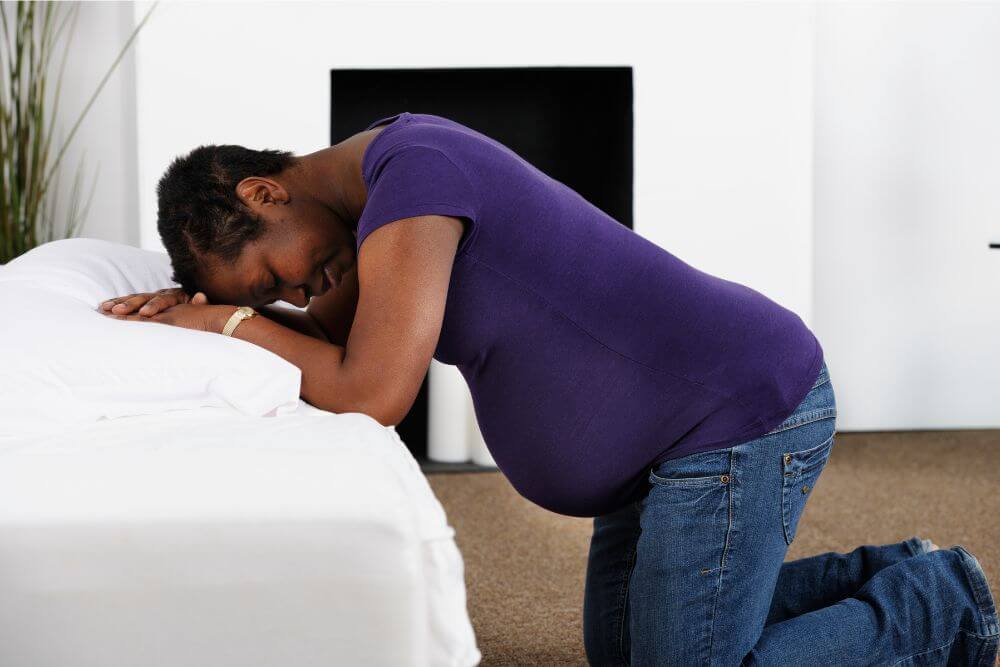Every woman’s experience of labour and birth is different. Nobody can predict what your labour will be like, or how long it will last.
However, there are plenty of things you can do to prepare yourself and, understanding what is happening to your body and your baby during labour is an important first step.
Traditional birth preparation classes describe labour as having 3 distinct stages, but this gives no indication of how labour actually feels. These 3 stages of labour are often the focus when care providers are assessing your progress and whether the labour is progressing along a recognised time curve or whether labour is progressing slower than this.
Natural birth advocates refute this approach for lower-risk pregnancies as clock watching and trying to compare all labours against a neat timeline is not always helpful, and we know that all labours vary in their duration. This is one of the biggest reasons to stay at home for as long as you can when the contraction surges start so that you are less likely to have any medical interference.
In my Complete Hypnobirthing and Newborn Course we explore the 14 phases of childbirth and discuss how to manage these so that you can birth like a boss !
Let’s look at some of the key stages of labour and what’s happening in your body
First stage of Labour – The contracting phase
The first stage of labour is really where most of the work happens! Think about planning an event: the preparation phase is always longer, more challenging (and often more uncomfortable) than the actual main event.
The first stage of labour is the longest of all the stages, typically lasting somewhere between 12 and 18 hours with a first birth and half that time with consecutive births.
The first stage of labour is further divided into these 3 phases:
1. Early Labour
This stage is also known as the latent phase. During latent labour, your cervix will open to around 3 centimetres. Your uterine muscles start to flex sporadically, with typically shorter contractions and longer stretches between each one. There is no rhythm to the contractions at this stage and they are quite uncoordinated. The contraction surges can feel like period pain, and they come and go in waves.
This can go on for a few hours or a few days, with contractions becoming more regular and intense as time goes on. Movies often show women suddenly being struck by painful contractions and rushing to hospital. In real life, labour unfolds gradually, giving you a chance to get organised, catch your breath and contact your care provider.
The waters surrounding baby might release at this stage, or they may not release until labour is much more advanced. Sometimes they release before you have any contractions, and sometimes they don’t release at all and baby is born in the sac of waters. This phase generally moves quicker if you can keep relaxed and keep adrenaline under control.
2. Active labour
Also known as the ‘foot on the gas’ phase. Brace yourself, as this is when labour unmistakably takes a turn and the power of the contraction surges ramps up in frequency, intensity and length. Your cervix will dilate further, and you will feel your baby slowly nestling down lower into your pelvis.
At the same time, your bodies natural pain relieving hormones known as endorphins are flowing through your body and you may feel as if you are in a dream-like state.
You won’t feel like talking during surges, but you will find deep, rhythmical breathing to be hugely beneficial.

Stay at home as long as you can if you are planning to birth in a hospital or birth centre and call the unit if you need reassurance or if your waters break at this stage and get some advice. Call the unit when you feel you need to go in for additional support or comfort, or call your support team if you are planning a home birth.
3. Transition
Transition is literally the transition between the first and second stages of labour when you start to feel the urge to push. Labour contractions have been dilating the cervix and it’s open and ready for the second stage, when a series of involuntary contractions push baby through the vagina to be born.
Transition is often described as the most challenging part of labour. It’s also the shortest and signals to you and your midwife that your baby will be born soon. Many women will doubt their ability to go on at this stage, requesting pain relieving medication or worrying about how much longer it will take.
Like other stages of labour, every woman’s experience of transition will be different. For some, the shift from active labour contractions to pushing is unremarkable. Other women experience any number of signs that they have reached this milestone.
Emotional Signs Of Transition
A very common emotional sign of transition is the ‘I’m done/I can’t’ stage. You may suddenly wake up out of the endorphin soaked haze you’ve been in for some time, and just decide you can’t have this baby today. Or you need drugs right now. You might be incredibly irritated by everything and everyone around you.
Some women become incredibly focused and almost withdraw into themselves. They may find it difficult to communicate, although they will say later they could hear and understand what was being said, they just couldn’t respond.
Restlessness is another common emotional sign of transition. Not knowing where to put yourself, wanting to be touched then hating it, wanting company then telling everyone to leave.
For many women, this is the time you may meet your primal self! Many women roar, grunt, moan or wail without consciously being aware of making any sound. These noises are powerful signs you’re close to birthing your baby.
When transition hits, it can bring with it a surge of fear and uncertainty. These emotions are powerful but they aren’t permanent and you’ll soon leave them behind as you start to work with your body. Transition is a signal birth is close, and it won’t be long before you meet your baby. Having a good birth team who supports birth as a natural process can ease you through this challenging time in labour.
Second stage of Labour – The pushing phase
Many women find that this part of labour is liberating. It can feel a huge release to be actually doing something with the contractions. Sometimes women say that the contractions become less painful or even pleasant. Others find this part of labour very challenging, both physically and emotionally. The important thing is that you have people around you supporting you, making sure you have adequate physical energy by offering you drinks and snacks, and that you are warm and comfortable enough and feel as private and safe as you need.
Try not to labour In a sitting or lying back position. Simply turning onto your knees or standing will open your pelvis by up to 30 % giving baby more room to manoeuvre.

There are lots of opinions about pushing. Some think the only way to gently birth is to simply ‘breathe the baby out’ and that this means denying the urge to push and to just keep breathing slowly and deeply.
It is not about trying not to push but merely about allowing your body to show you the way – moving, breathing, pushing as your body dictates. In a woman who is undisturbed and unselfconscious, this appears as a ‘breathing down’, a grunting push, a low moan or even a silent bearing down. A woman may find she needs to push, and push hard, to birth her baby. Someone else may find her baby slipping out with hardly a grunt. Each birth is different and perfect in its own way.
This phase can last from 30 minutes to 3 hours
Third stage of Labour – Birth of the placenta phase
The 3rd stage of labour happens after your baby is born, when your womb contracts further and the placenta comes out through your vagina.
There are 2 ways to manage this stage of labour:
- active – when you have treatment to make it happen faster
- physiological – when you have no treatment and this stage happens naturally.
Your midwife will explain both ways to you while you’re still pregnant or during early labour, so you can decide which you would prefer. There are some situations where physiological management is not advisable. Your midwife or doctor can explain if this is the case for you.
This phase can last from 10 minutes to 1-2 hours
How to prepare for your stages of labour.
Getting as prepared as you can and understanding what’s happening in your body during labour will help you to feel calm and confident, and in turn this will allow the hormones of labour to flow in abundance.
I would love to help you to learn more about the many the stages of labour in more detail – join me in my Complete Hypnobirthing and Newborn Course and let’s explore all the 14 phases of childbirth in more depth, along with other parents during our ‘Live with Linda’ Question and Answer Sessions.











0 Comments